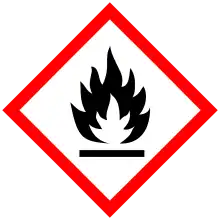| |||
| Names | |||
|---|---|---|---|
| Preferred IUPAC name
Ethanethioic S-acid[1] | |||
| Other names
Thioacetic S-acid Thiolacetic acid | |||
| Identifiers | |||
3D model (JSmol) |
|||
| ChEBI | |||
| ChemSpider | |||
| ECHA InfoCard | 100.007.331 | ||
| KEGG | |||
PubChem CID |
|||
| UNII | |||
CompTox Dashboard (EPA) |
|||
| |||
| |||
| Properties | |||
| CH3C(O)SH | |||
| Molar mass | 76.11756 g/mol | ||
| Appearance | Transparent, colorless to light yellow liquid[2][3] | ||
| Odor | Unpleasant, strong thiol-like | ||
| Density | 1.08 g/mL | ||
| Melting point | −58 °C (−72 °F; 215 K) | ||
| Boiling point | 93 °C (199 °F; 366 K) | ||
| −38.4·10−6 cm3/mol | |||
Refractive index (nD) |
1.465 | ||
| Hazards | |||
| Occupational safety and health (OHS/OSH): | |||
Main hazards |
Severe skin burns and eye damage. Highly flammable. | ||
| GHS labelling: | |||
    | |||
| Danger | |||
| H225, H301, H302, H314, H317 | |||
| P210, P233, P240, P241, P242, P243, P260, P261, P264, P264+P265, P270, P272, P280, P301+P316, P301+P317, P301+P330+P331, P302+P352, P302+P361+P354, P303+P361+P353, P304+P340, P305+P354+P338, P316, P317, P321, P330, P333+P317, P362+P364, P363, P370+P378, P403+P235, P405, P501 | |||
| Lethal dose or concentration (LD, LC): | |||
LD50 (median dose) |
75 mg/kg (mouse, intraperitoneal) | ||
| Safety data sheet (SDS) | Fischer Scientific | ||
Except where otherwise noted, data are given for materials in their standard state (at 25 °C [77 °F], 100 kPa).
Infobox references | |||
Thioacetic acid is an organosulfur compound with the molecular formula CH3C(O)SH. It is a thioic acid: the sulfur analogue of acetic acid (CH3C(O)OH), as implied by the thio- prefix. It is a yellow liquid with a strong thiol-like odor. It is used in organic synthesis for the introduction of thiol groups (−SH) in molecules.[4]
Synthesis and properties
Thioacetic acid is prepared by the reaction of acetic anhydride with hydrogen sulfide:[5]
- (CH3C(O))2O + H2S → CH3C(O)SH + CH3C(O)OH
It has also been produced by the action of phosphorus pentasulfide on glacial acetic acid, followed by distillation.[6]
- CH3C(O)OH + P2S5 → CH3C(O)SH + P2OS4
Thioacetic acid is typically contaminated by acetic acid.
The compound exists exclusively as the thiol tautomer, consistent with the strength of the C=O double bond. Reflecting the influence of hydrogen-bonding, the boiling point (93 °C) and melting points are 20 and 75 K lower than those for acetic acid.
Reactivity
Acidity
With a pKa near 3.4, thioacetic acid is about 15 times more acidic than acetic acid.[7] The conjugate base is thioacetate:
- CH3C(O)SH → CH3C(O)S− + H+
In neutral water, thioacetic acid is fully ionized.
Reactivity of thioacetate
Most of the reactivity of thioacetic acid arises from the conjugate base, thioacetate. Salts of this anion, e.g. potassium thioacetate, are used to generate thioacetate esters.[8] Thioacetate esters undergo hydrolysis to give thiols. A typical method for preparing a thiol from an alkyl halide using thioacetic acid proceeds in four discrete steps, some of which can be conducted sequentially in the same flask:
- CH3C(O)SH + NaOH → CH3C(O)SNa + H2O
- CH3C(O)SNa + RX → CH3C(O)SR + NaX, where X = Cl, Br, I
- CH3C(O)SR + 2 NaOH → CH3CO2Na + RSNa + H2O
- RSNa + HCl → RSH + NaCl
In an application that illustrates the use of its radical behavior, thioacetic acid is used with AIBN in a free radical mediated nucleophilic addition to an exocyclic alkene forming a thioester:[9]
 thioacetic acid application
thioacetic acid application
Reductive acetylation
Salts of thioacetic acid such as potassium thioacetate can be used convert nitroarenes to aryl acetamides in one step. This is particularly useful in the preparation of pharmaceuticals, e.g., paracetamol.[10]
References
- ↑ International Union of Pure and Applied Chemistry (2014). Nomenclature of Organic Chemistry: IUPAC Recommendations and Preferred Names 2013. The Royal Society of Chemistry. p. 97. doi:10.1039/9781849733069. ISBN 978-0-85404-182-4.
- ↑ https://pubchem.ncbi.nlm.nih.gov/compound/Thioacetic-acid
- ↑ https://www.sigmaaldrich.com/GB/en/sds/aldrich/t30805
- ↑ Jeannie R. Phillips "Thiolacetic Acid" Encyclopedia of Reagents for Organic Synthesis, 2001 John Wiley. doi:10.1002/047084289X.rt096
- ↑ Ellingboe, E. K. (1951). "Thiolacetic acid". Organic Syntheses. 31: 105. doi:10.15227/orgsyn.031.0105.
- ↑ Schiff, Robert (1895-08-09). "Preparation of Thioacetic Acid and its Importance for Chemical-Legal Investigations". Chemical News and Journal of Industrial Science. 72: 64. Retrieved 2016-11-02.
- ↑ Matthys J. Janssen "Carboxylic Acids and Esters" in PATAI'S Chemistry of Functional Groups: Carboxylic Acids and Esters, Saul Patai, Ed. pp. 705–764, 1969. doi:10.1002/9780470771099.ch15
- ↑ Ervithayasuporn, V. (2011). "Synthesis and Characterization of Octakis(3-propyl ethanethioate)octasilsesquioxane". Organometallics. 30 (17): 4475–4478. doi:10.1021/om200477a.
- ↑ Synthesis of methyl 6-deoxy-4-O-(sodium sulfonato)-α-L-talopyranoside, its C-4 epimer and both isosteric [4-C-(potassium sulfonatomethyl)] derivatives László Lázár, Magdolna Csávás, Anikó Borbás, Gyöngyi Gyémánt, and András Lipták Arkivoc 2004 (vii) 196-207 Link
- ↑ Bhattacharya, Apurba; et al. (2006). "One-step reductive amidation of nitro arenes: application in the synthesis of Acetaminophen" (PDF). Tetrahedron Letters. 47: 1861–1864. doi:10.1016/j.tetlet.2005.09.196. Retrieved 2016-11-02.

